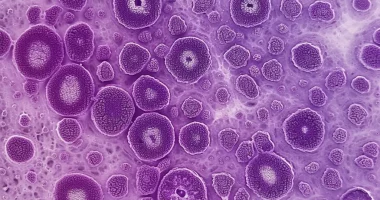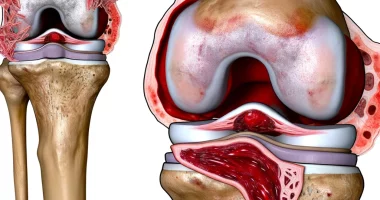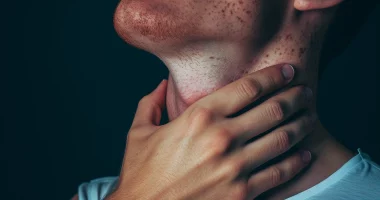Knee pain
Definition
Knee pain limits a person’s mobility and can indicate the development of serious pathologies. Taking analgesics does not solve the problem: only an experienced doctor, after diagnosis, can prescribe a treatment that will eliminate pain and preserve the health of one of the largest joints in the body.
Diseases
The causes of knee joint pain are associated with many chronic and acute pathologies:
- Bursitis
- Knee sprain
- Purulent arthritis
- Osteoporosis
- Knee meniscus injury
- Gout
- Knee contusion
Diagnosis
To identify the cause of pain syndrome, the doctor performs an examination and palpation and assesses the mobility of the knee joint. At the stage of collecting anamnesis, he finds out clinically relevant information about chronic diseases of the musculoskeletal system in close relatives, the time and presumed causes (trauma, increased load) of the symptom, the frequency of occurrence, and the severity of discomfort.
The following examinations are considered the main ways to diagnose knee joint pain.
- Radiography of the knee joint evaluates the structure and detects significant abnormalities, as well as fluid in the joint cavity.
- Computed tomography of the knee: This procedure studies the structure of the joint through a series of X-ray layer-by-layer images and exposes the tumor by injecting radioactive material into the patient’s bloodstream.
- MRI of the knee: to create a three-dimensional joint model, which allows the smallest structural changes to be detected.
- Ultrasound of the knee is used to study the condition of the soft tissues, identifying foci of pus, exudate accumulation, or blood.
- Arthroscopy: for diagnosis and therapy, inserting an arthroscope into the joint through an incision in the skin allows the joint to be examined from the inside and fluid buildup to be removed if necessary.
In addition to imaging methods that allow a detailed study of the state of the joint tissues, tendons, ligaments, and soft tissues, the diagnosis prescribed for knee pain also includes laboratory tests: general and biochemical blood tests, rheumatic tests, and bacterial seeding of synovial fluid. These tests help the doctor understand whether the cause of knee pain is inflammation, an autoimmune process, infection, or other diseases.
Types of knee pain
In terms of frequency and periodicity of occurrence, the pains are.
- Ad hoc or one-time: usually related to specific external causes, such as staying in an uncomfortable position.
- Intermittent: occurs with increased stress on the joint during walking and sports, wearing uncomfortable shoes, and causing a recurrence of the disease.
- Chronic: bothersome all or most of the time, associated with the progression of a particular disease.
The patient may characterize the sensations as cutting, tearing, pulling, or aching. Depending on the cause of the pain syndrome, complaints may also include skin redness, swelling, decreased mobility, clicking, and crunching when bending the joint.
Causes of knee pain
The most common provocateurs of knee pain are:
- hard and soft tissue injuries;
- mechanical damage;
- inflammation;
- dystrophic changes;
- metabolic disorder;
- neuritis and other neurological disorders.
Pain syndrome can be a manifestation of mental illness, such as hidden depression. Somatoform disorders are diagnosed when the complaint occurs regularly, but the examination does not reveal any disorders that could cause pain.
The risk of encountering pain syndrome of any etiology in the area of the knee joint is higher on the background:
- obesity;
- improper nutrition or impaired digestion;
- of a complicated hereditary factor;
- other pathologies of the musculoskeletal system;
- overuse of the limbs or hypodynamia;
- alcohol dependence and taking certain medications;
- older age.
Commonly associated pathologies
Pain syndrome in the knees is associated with many pathologies. The nature of the symptom may differ with different causes of occurrence, but only a doctor can make an accurate diagnosis.
Rheumatoid arthritis
In this pathology, inflammation of the joints is associated with the hyperactivity of the immune system, which produces antibodies to affect its own tissues.
Symptoms also include:
- stiffness in the body in the morning;
- general weakness;
- subfebrile fever;
- restricted mobility.
In rheumatoid arthritis, all joints, including the knees, are affected symmetrically.
Gout
The disease deposits excess uric acid in the body’s tissues, which should normally be excreted by the kidneys. Joint pain is often the first sign of the disease, along with which there are observed in the area of the joint location:
- redness of the skin;
- swelling;
- localized fever.
Pathology is more common in women and those with excessive body weight.
Bursitis
This disease occurs with increased load on the joint with subsequent inflammation of the periarticular bag, less often – with infections, toxicosis, and failures in the immune system.
Symptomats include:
- pain;
- swelling;
- traffic restriction;
- Redness and increased skin temperature in the area of the joint.
Bursitis usually occurs in athletes who do not calculate loads correctly, including not adjusting for age-related changes.
Osteoarthritis
The patient experiences cartilage thinning and bone destruction in this disease due to degenerative and dystrophic processes. The predisposing factors are age, trauma, complicated genetic history, infections, and excessive immune activity.
Examination reveals:
- restricted mobility;
- swelling;
- pain when pressing on the skin in the area of the joint;
- crunching, snapping when you move.
Arthritis often accompanies other musculoskeletal system pathologies, which can affect one or more joints.
Osteoporosis
Patients with this pathology suffer from increased bone fragility due to an imbalance between calcium intake and bone output. As bone structure changes, pressure on soft tissues and nerve fibers increases, causing pain.
The clinical picture also includes:
- frequent fractures;
- growth reduction;
- spinal curvature.
Osteoporosis is more often detected in women during menopause, which is due to the impact of hormonal background on calcium metabolism in the body.
Treatment for knee pain
The treatment prescribed for knee pain depends on the cause of its development, the patient’s age, and concomitant pathologies. When identifying the specific factor that causes joint pain, a course of therapy aimed at the root cause is prescribed to eliminate it or completely put it into a stable remission.
Treatment for knee joint pain includes the following techniques.
- Pharmacotherapy administration of etiotropic and symptomatic drugs, as well as vitamins.
- Immobilization: temporary joint immobilization using medical devices to reduce stress and create favorable conditions for rapid recovery.
- Surgical intervention in case of low effectiveness of conservative therapy.
- Physical therapy: complementary treatments that improve blood supply and local metabolic processes in tissues for regeneration.
The therapeutic process is carried out on an outpatient basis. If surgical intervention is necessary, a short hospitalization is required. Chronic pathologies require constant medical supervision and prescription correction, so the patient must come to regular appointments.
All these treatment options are available in more than 800 hospitals worldwide (https://doctor.global/results/diseases/knee-pain). For example, Running injuries surgical treatment can be performed in these countries for following approximate prices:
Turkey $1.3 K in 26 clinics
Germany $6.6 K in 43 clinics
United States $7.3 K in 17 clinics
China $9.8 K in 8 clinics
Israel $10.3 K in 16 clinics.
Complications
Refusal of medical assistance in favor of self-treatment leads to the progression of the disease, disability, and spread of the pathological process.
Constant pain affects the quality of life:
- limits a person’s ability to be active and expend energy to maintain muscle tone and prevent the deposition of excess fat;
- often causes irritability and depression.
Chronic inflammation in the body increases the load on the immune system, which provokes the development of autoimmune pathologies or low resistance of the body to pathogenic factors.
With timely and adequate treatment, following the doctor’s recommendations usually provides a good prognosis and preserves the health of the musculoskeletal system.


